
Juan Thornhill and the safety’s put on a show on day four
The combine is in the books. So what did we learn?
Safety’s end the combine with a flourish
Coming into the combine it’s fair to say there wasn’t a lot of buzz about the safety class. That’s going to change after today.
Eleven players ran a 4.4 or faster. Two even ran in the 4.3’s with Ole Miss’ Zedrick Woods nailing the fastest time by anyone this year with a 4.29.
It’s worth noting that speed doesn’t necessarily translate to success at the next level. Here are the top-15 forty time by safety’s at the combine between 2010-2018:
Troy Apke — 4.34
T.J. Green — 4.34
Justin Cox — 4.36
Natrell Jamerson — 4.40
Obi Melifownu — 4.40
Justin Reid — 4.40
Dane Cruikshank — 4.41
Josh Jones — 4.41
Terrence Brooks — 4.42
Montae Nicholson — 4.42
Shamarko Thomas — 4.42
Taylor Mays — 4.43
Godwin Igwebuike — 4.44
Earl Wolff — 4.44
Budda Baker — 4.45
There’s not a lot of stars among the group. So although the 2019 safety class can run, it doesn’t mean they’re destined to succeed.
Even so, today was a big positive. Many players exceeded expectations. Here’s what stands out:
— Earlier today I suggested USC’s Marvell Tell could be a safety/corner convert for the Seahawks. He’s 6-2, 198lbs and he has 33 1/8 inch arms. He didn’t run a forty yard dash but the rest of his workout was incredible. He jumped a 42 inch vertical and an 11-4 broad. He ran a superb 6.63 in the three cone and a 4.01 in the short shuttle. He’s a player who warrants serious consideration for the Seahawks at safety or corner.
— Juan Thornill ran a 4.42 forty and jumped a 44 inch vertical plus an 11-9 broad. He didn’t do any of the agility tests. This combination of speed and explosive power doesn’t necessarily show up on tape where Thornhill looks a little stiff. However, he did have six interceptions in 2018 and the Seahawks need some playmaking ability in the secondary.
— Will Harris has been compared to Bradley McDougald in terms of playing style by Lance Zierlein. He ran a 4.41 which is significantly faster than McDougald. He added a 36.5 vertical, a 6.91 three cone and a 4.12 short shuttle. He’s tough, physical and has special teams value.
— Darnell Savage ran a blistering 4.36 and then jumped a 39.5 inch vertical. He also ran a 4.14 short shuttle but his 7.03 three cone was a little slower than some of the other safety’s. Even so, he’s a player I will go back and take another look at. He’s an excellent cover safety and clearly has the speed to play with range.
There are other names I could add to the list. I didn’t expect to see the kind of speed we witnessed today and the testing in the broad/vertical and short shuttle/three cone simply added to the quality of the workout. I want to go back and watch certain players and see what I missed. Why didn’t they look as fast as this on the first watch through? Did I miss something?
Either way, it seems more likely now than it was previously that the Seahawks will draft one of these safety’s. There are traits to work with here.
Cornerbacks lacking in round one
While the safety’s put on a show, the cornerbacks certainly didn’t. It’s difficult to look at this class and identify first round picks. Greedy Williams was supposed to be the guy and he ran a 4.37 forty. He then struggled badly with his back-pedal and transition, fell over a couple of times during drills and promptly ended his day citing ‘cramps’.
Byron Murphy had a much better performance in drills but is undersized and ran a 4.55. Can you justify taking his physical profile in round one? Joejuan Williams (4.64) surely didn’t run well enough to justify the recent first round buzz.
The good news for the Seahawks is there are plenty of long, lean cornerbacks who might be available in the range they take their DB’s. There were 16 corners with +32 inch arms at the combine.
Of today’s group, Lonnie Johnson and Michael Jackson impressed with their forty times and workouts. Derrek Thomas looks the part of a Seahawks corner.
Some will go too early. Justin Layne might’ve performed well enough to move into the top-50 range. Daniel Jeremiah also suggested Isaiah Johnson could be a second round pick.
Jordan Miller, Joejuan Williams and Jamal Peters might last into range.
For a team like Seattle that gets its cornerbacks later on, this class isn’t a problem. If your biggest need is cornerback and you were hoping to get one in the first frame, you’re out of luck.
Overall assessment of the combine
Depth is not a problem in 2019
This is a deep looking draft class. The O-liners set the ball rolling with a fantastic Friday and the tight ends and receivers continued the momentum on Saturday. We already knew there were a ton of defensive linemen. Then the safety’s joined the party. There’s going to be depth and quality stretching into day three this year.
The Seahawks have to get more picks
Anyone writing a mock draft in the next few days might have a hard time filling picks 20-32. This isn’t a class with a thick base of legit first round prospects. There are a lot of guys you’ll feel more comfortable projecting at #45 than #25.
As soon as you get into the second, third and fourth round however — that’s where you’re going to find the riches. In particular, there will be plenty of offensive linemen, tight ends, receivers and defensive linemen available in this range.
Seattle’s most pressing need is to retain their core players in free agency then add depth and competition to what is already a playoff roster. They need to find a way to turn their four picks into eight. That likely means trading down from #21 multiple times.
They have to find a solution at linebacker
The Seahawks have consistently drafted outstanding athletes at linebacker. This draft class has two outstanding athletes — Devin White and Devin Bush. Both will go early in the first round. Most of the other prospects are a mash-up of likely special teams contributors and backups.
If you were hoping there’d be a ready-made linebacker to come in as a rookie and start, it’s not looking promising. Will this increase their desire to retain K.J. Wright? Will they move quickly to sign Mychal Kendricks if he avoids jail? Do they sign another veteran free agent? At the very least they’ll need to add a hedge. One way or another this seems like it’ll be a priority position for the Seahawks when free agency begins.
Beware the hype
Montez Sweat and D.K. Metcalf made headlines at the combine. So did Brian Burns to a slightly lesser extent. You’ll likely see all three promoted high into the first round in mock drafts this week.
It won’t be a shock if all three go in the top-20. As mentioned earlier, it’s not a great looking first round. Players with massive upside and unique traits have a chance to move up boards. Yet there are question marks with all three to go with the insane combine hype.
Sweat ran a superb 4.41 forty and his straight line speed is not in doubt. However, he looked stiff and awkward during drills working in space. He’s a pure EDGE and not really an option for 3-4 teams at outside linebacker. He also has some character questions to answer following his departure from Michigan State.
Metcalf ran a blistering 4.33 forty at 228lbs and looked incredible. However, there are legit concerns that he’s just too big. A 4.50 short shuttle and a 7.38 three cone are times you’d expect to see from an athletic defensive tackle. On tape he separates running go-routes and the 4.33 speed is very evident. Yet he struggles to separate on quicker, shorter routes and those shuttle and cone times will add to concerns that he’s simply too big and stiff to be a threat as anything other than a downfield receiver. There are also medical concerns about a serious neck injury that ended his 2018 season and he has a few too many concentration drops.
Burns reportedly played at about 227lbs during the 2018 season. Any concerns about his size were addressed at the combine. He showed up at 249lbs and had a fantastic workout. It was particularly impressive to see how smooth he looked running linebacker drills in space and unlike Sweat he’s very much an option for teams who run a 3-4 scheme. However, can he keep this weight on? And are 4-3 teams prepared to draft a 240-250lbs EDGE in the first round? He’s still undersized even if he sticks at about 250lbs.
By all means celebrate what all three achieved at the combine. As per usual, however, there’s another side of the story to consider.
Frank Clark franchise tag could be problematic
There’s still time to get a long term deal done and maybe giving Clark the tag will act as a catalyst to conclude a contract. However, as things stand the Seahawks have four key players entering the final year of their contracts — Clark, Russell Wilson, Bobby Wagner and Jarran Reed. They cannot go into the next off-season with all four unsigned and only one franchise tag available. This is probably the #1 problem to solve this off-season.
Position by position combine analysis with a Seahawks slant
Offensive line
The O-liners put on a show. It was a more explosive class than previous years. Andre Dillard likely secured a place in the top-15 as the most athletic prospect and by far the best pass-protector in the draft. Garrett Bradbury is very likely to go in round one after he excelled in drills and put on an explosive testing performance. Chris Lindstrom is very much in play to be a top-50 pick after he ran a superb forty and had an explosive workout. Two center’s — Elgton Jenkins and Erik McCoy — further enhanced their stock after a strong Senior Bowl. Washington’s Kaleb McGary looked sensational with a fantastic, muscular frame. The league is desperate for quality offensive tackles and after he showed well in drills and had an explosive workout — I wouldn’t be surprised if he found his way into the top-40. Two Ohio State players — Isaiah Prince and Michael Jordan — also performed well in drills and looked highly athletic. They bolstered their stock in Indianapolis.
What could the Seahawks do?
Pete Carroll stated at the combine it was a priority to keep the O-line together. It’s likely they’ll re-sign J.R. Sweezy and D.J. Fluker. One player in particular stood out as an alternative though. Chris Lindstrom ran a 4.91 forty, a 4.54 short shuttle, he was explosive in the vertical and broad and he has ideal size at 308lbs and 34 1/8 inch arms. If the Seahawks don’t re-sign Sweezy, Lindstrom looks like a strong candidate as an option at left guard. There weren’t any massive, beastly right guards that look like they could fill a D.J. Fluker sized hole. I suspect Fluker will be re-signed as a priority. There are options throughout this class and it won’t be a surprise if they add some depth even if the 2018 starters are retained.
Running back
The 2018 draft was the year of the running back. 2019 is be the opposite. The only likely first round runner — Josh Jacobs — didn’t perform at the combine. The rest of the group failed to dazzle. It won’t be a surprise if Jacobs is the only running back taken in the first two rounds. There will be some possible value in the middle rounds. Overall though — if you like your running backs, last year was the year to get one.
What could the Seahawks do?
Having spent a first round pick on Rashaad Penny a year ago and with Chris Carson developing into one of the best in the league, they’re left looking for a possible third wheel. With the way the backs tested they might be more inclined to try and keep Mike Davis. If they do draft a new runner keep an eye on Alexander Mattison, Alex Barnes and Miles Sanders. I suspect the Seahawks are more likely to draft a full back than a running back this year. Wisconsin’s Alec Ingold could be the guy.
Tight end
The NFL is desperate for quality tight ends and this is a class rich in depth. T.J. Hockenson almost certainly secured his place in the top-11 with a terrific combine. Iowa team mate Noah Fant performed as expected and will be at worst a second round pick. Irv Smith Jr ran solidly but didn’t do as well in the agility tests. His NFL bloodlines and ability to act as a ‘big slot’ could make him an option for teams in the 20’s or 30’s. The best thing about this class though is what follows. We could see an army of TE’s drafted between rounds 2-4. Josh Oliver, Dawson Knox, Drew Sample, Kaden Smith, Trevon Wesco, Foster Moreau and several others all impressed. If you want to draft a tight end you’ll be able to find one you like this year.
What could the Seahawks do?
The Seahawks are likely to take a long look at this group. Nick Vannett is entering the last year of his contract, Will Dissly is recovering from injury and Ed Dickson is a veteran stop-gap. They’re more likely to look at the Y-TE’s than the joker’s or move TE’s. Drew Sample would be a fine option but he’s possibly moved his stock into round three after a great Senior Bowl and combine. Trevon Wesco is a bad dude and could be added to act as a blocking TE and possible full back. Kaden Smith tested well in terms of agility and is a well-balanced tight end who could be dropping. If he’s there on day three he could be a value pick. Foster Moreau had a brilliant combine and also has some FB/TE crossover potential.
Wide receiver
This is a very similar group to the tight end class. There aren’t many first round prospects. The likes of D.K. Metcalf and Parris Campbell possibly pushed themselves into that range but it’s not a lock. Deebo Samuel and Marquise Brown also have a chance to go in the first frame. It’s the depth that really makes this class. You’ll be able to take a receiver in rounds 2-4 that you really like. It’s a really fast group with bigger and smaller wide outs. The big guys are Metcalf, Miles Boykin or Hakeem Butler. N’Keal Harry also had a faster forty time than expected at 4.53. If you want a burner the options include Terry McLaurin and Emanuel Hall. Gary Jennings at West Virginia tested well. Deebo Samuel and A.J. Brown both ran in the late 4.4’s. Parris Campbell is the definition of a modern day playmaker.
What could the Seahawks do?
The inconsistency of David Moore has opened the door for a possible addition of a third target. Tyler Lockett is locked in for the long term and Doug Baldwin still has two years remaining on his contract. Given the sheer depth of options it’s very possible the Seahawks will draft a receiver at some stage. They’ve drafted nine receivers in the Pete Carroll era. All but two ran a 4.4 forty (and one was seventh round flier Kenny Lawler). There were 18 receivers who ran a 4.4 or faster in Indianapolis — so they should be able to find some players they like.
Quarterback
It was difficult to analyse the quarterbacks at the combine. The constantly changing camera angles destroyed any concept of depth and velocity on throws and it wasn’t always clear who was actually throwing the football. From what little I was able to gather — Drew Lock and Dwayne Haskins both showed off plenty of arm talent (although Haskins appeared to be inconsistent with his accuracy) and Jarrett Stidham looked very comfortable too. Kyler Murray didn’t throw but all of the talk is that he’ll be the #1 pick to Arizona — a suggestion we discussed a couple of months ago.
What could the Seahawks do?
We’ve talked a lot about the possibility of a long and frustrating contract saga with Russell Wilson. If he intends to play on the franchise tag and resist signing a long-term extension, the Seahawks have to prepare and plan accordingly. They have to consider drafting a quarterback. If nothing else you might end up with a cheap developmental player and a solid backup. The best case scenario is you prepare for the worst — an ugly and hopefully avoidable divorce from your franchise quarterback. That said, you still need to rate the options available. I suspect the NFL likes Will Grier a lot more than the media. Here’s one of the reasons why. Here’s another. Grier has been the best deep-ball passer for the last two years in college football. The Seahawks love downfield and explosive completions in the passing game. I’m not sure what kind of range they might be comfortable taking him but Grier is the name I think might interest them the most within this class. If that isn’t the case or he’s taken too early — there’s not much you can do about it.
Defensive tackle and inside/out rusher
The expectation was this would be the group to set the combine alight. It didn’t quite live up to expectations. A number of key players either didn’t run the forty or didn’t do drills. Dexter Lawrence ran a fantastic 5.05 at 342lbs but got injured while running. Christian Wilkins wasn’t as athletic or explosive as I expected. Rashan Gary stood out and looked every bit a top-10 lock. Quinnen Williams ran a fantastic forty. Ed Oliver didn’t run but tested well in the broad and vertical. The others to impress included a really athletic performance from Jerry Tillery, Zach Allen recovered some of his lost stock from the Senior Bowl and Renell Wren, as expected, had a great workout. The best options could be in the middle rounds though. UCF’s Trysten Hill had an excellent performance during drills and could be a value starter at defensive tackle. Daniel Wise is a dynamic interior rusher. Charles Omenihu has incredible 36-inch arms and had a good workout. Keke Kinglsey’s tape is average but he had a great Senior Bowl and followed it up with a good combine. L.J. Collier lacks quickness and agility but has good length and is very explosive.
What could the Seahawks do?
It’s hard to say. They drafted Rasheem Green a year ago to play inside/out and presumably they still believe he can develop into a starter. They’ve regularly preferred to sign cheap veteran defensive tackles instead of using high draft picks (with the one exception being Jarran Reed). They really need to add a strong run defender at some point this off-season. Adding some extra pass rush is also important and it’s always possible they seek to use Green as more of an orthodox defensive end. History tells us they value the short shuttle at the two positions and a cluster of players tested well there. Zach Allen (4.36) could be a second-round target to play as a big end who kicks inside. Jerry Tillery (4.33) can play inside and five-technique. Charles Omenihu (4.36) has fantastic size, length and quickness. Daniel Wise (4.36) could be added as a specialist interior rusher. Trysten Hill (4.38) screams value pick and a possible starting defensive tackle. Kingsley Keke (4.46) has the kind of sparky character they seem to like. Dre’Mont Jones (4.53) is a dynamic pass rusher. Renell Wren (4.53) is inconsistent and played without control at Arizona State but he has the traits they like and the quickness.
EDGE rusher
Montez Sweat made headlines with his record-breaking 4.41 forty. Brian Burns also impressed — especially considering he’d added approximately 20lbs. Both players leave the combine with their stock trending upwards. It’s no surprise Nick Bosa tested very well and he’s likely a top-three pick. Josh Allen worked out with the linebackers but he’s an EDGE and had a solid workout, running a decent forty and testing well in terms of agility. Ben Banogu had an amazing workout. He’s the most explosive TEF tester we’ve ever recorded with the exception of one player — Myles Garrett. Chase Winovich is bigger, faster and more explosive than a lot of us expected. Justin Hollins had a solid workout. There were some disappointments too. Jachai Polite ran poorly then pulled out with an injury. Clelin Ferrell didn’t run a forty. Christian Miller and D’Andre Walker are still recovering from injuries suffered at the end of the college football season. Is it a particularly deep EDGE class? Not really.
What could the Seahawks do?
The Dion Jordan project didn’t really work out. Assuming he isn’t retained, the greater need in Seattle is for an EDGE rather than a SAM/LEO or inside/out rusher. If they trade down and Montez Sweat or Brian Burns are available, they could be the first pick. After their combine performances, they’re less likely to be available. Christian Miller is a nice alternative with his length, explosive power and college production. I’m going to study Ben Banogu this week after his great combine. Overall though there’s not a great deal of depth. For that reason, they might need to see what’s available in free agency. Adding one of the available pass rushers to play across from Frank Clark might be important — even as a hedge. Is Anthony Barr affordable? What other options are there? It’s something to keep in mind when the market opens. It’s not obvious Seattle will be able to find a solution in the draft.
Linebacker
Several positions flashed great depth and quality at this combine. Linebacker was not one of them. Devin White and Devin Bush ran a 4.42 and a 4.43 respectively. Both jumped around the 40 inch mark in the vertical. Bob McGinn’s sources indicated both players were being graded similarly going into the combine. It seems likely both will leave the board in round one — possibly in the top-20. Mack Wilson, another possible high pick, didn’t work out due to injury. Apart from that — this looks like a class rich in backup-level talent.
What could the Seahawks do?
Assuming White and Bush will both be gone, there’s not much they can do. There’s not an obvious ‘Seahawks’ linebacker in this class. Certainly there’s nobody you’d feel very confident in coming in to start at WILL as a rookie. They need a plan in free agency. Re-sign K.J. Wright, re-sign Mychal Kendricks or sign another veteran.
Cornerback
This isn’t a good cornerback class in terms of early round picks. In terms of role players and long, lean cornerbacks? There are options later on. Greedy Williams was seen as the corner most likely to be drafted first. He ran a decent 4.37 forty but did not look good during drills. His back pedal was slow, he was too upright and he was flat-footed. His transitions were sluggish. He bailed half way through the on-field work complaining about cramps. If Williams goes in round one — and it’s not a lock — he might be the only one. This is not a good year if you want an elite round one corner.
What could the Seahawks do?
It might not be a good draft for early round cornerbacks but there are plenty of options for Seattle in the middle or later rounds. There were 16 corners with +32 inch arms at the combine. Depth and competition at the position is vital and it’s very likely the Seahawks will draft at least one cornerback. Justin Layne and Isaiah Johnson might go a bit too early for Seattle. Lonnie Johnson and Jamal Peters, however, might be available in their preferred day-three range. Derrek Thomas looked incredibly long and lean. He ran a quick forty and has 34 inch arms and an 82 inch wingspan. He’s very much a name to remember. Washington’s Jordan Miller also ran well and Miami’s Michael Jackson had an excellent workout during drills. Jackson is a big, physical looking corner who flashed quick transitions and a smooth back pedal.
Safety
The safety class put on a show today and wowed with an unexpected level of speed, explosion and agility. There might not be a safety worthy of a first round pick (although Johnathan Abram running a 4.45 puts him in contention) but the depth between rounds 2-4 looks a lot stronger than it did 24 hours ago. The receiver, tight end, O-line and safety positions are all very similar. Minimal options in round one, good depth from day two onwards.
What could the Seahawks do?
Before today I thought this could be a position they passed on. They seem to like their existing safety’s more than the fans and media. However, after such an impressive combine showing they’ll likely be tempted to add some speed and competition to the position. A year ago they drafted a safety (Tre Flowers) and moved him to corner. Going into today, I thought Marvell Tell could be a similar project. He’s 6-2, 198lbs and has 33 1/8 inch arms and had an incredible performance. Whether they consider him at cornerback or safety — he has to be on the radar. Juan Thornhill had six picks in 2018 and runs in the 4.4’s. Could they bring him in to push Tedric Thompson? Will they have interest in the coverage ability of Darnell Savage or the rounded game of Will Harris? There are other names to mention. With so much speed and athleticism within this group, I’ll spending a lot more time studying the available options.
You can now support Seahawks Draft Blog via Patreon by clicking the tab below.



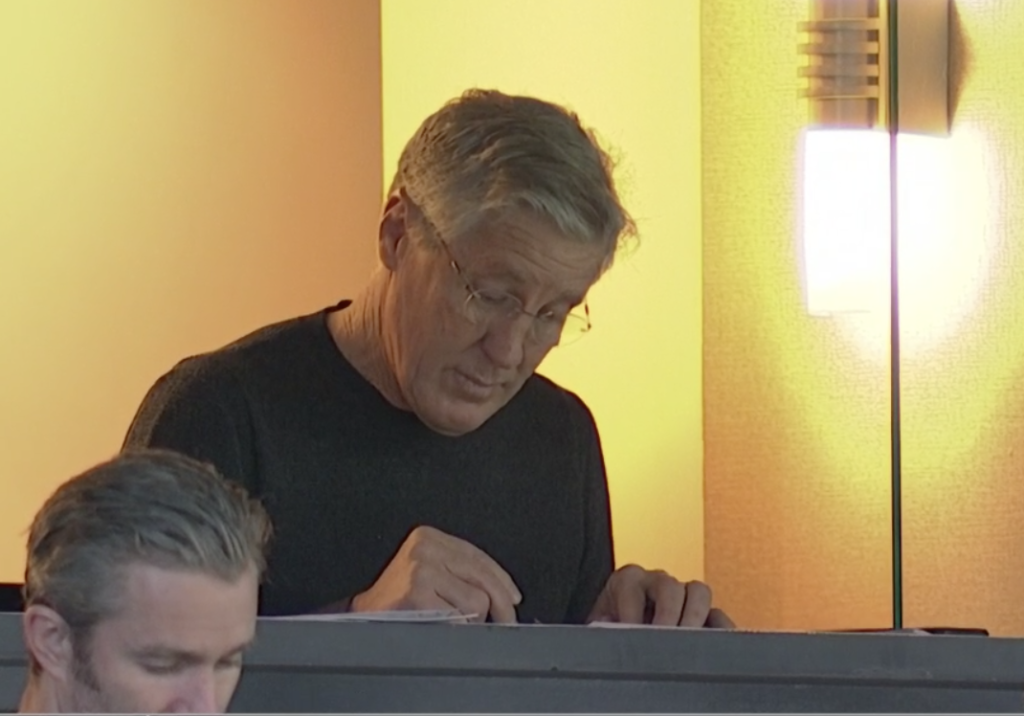
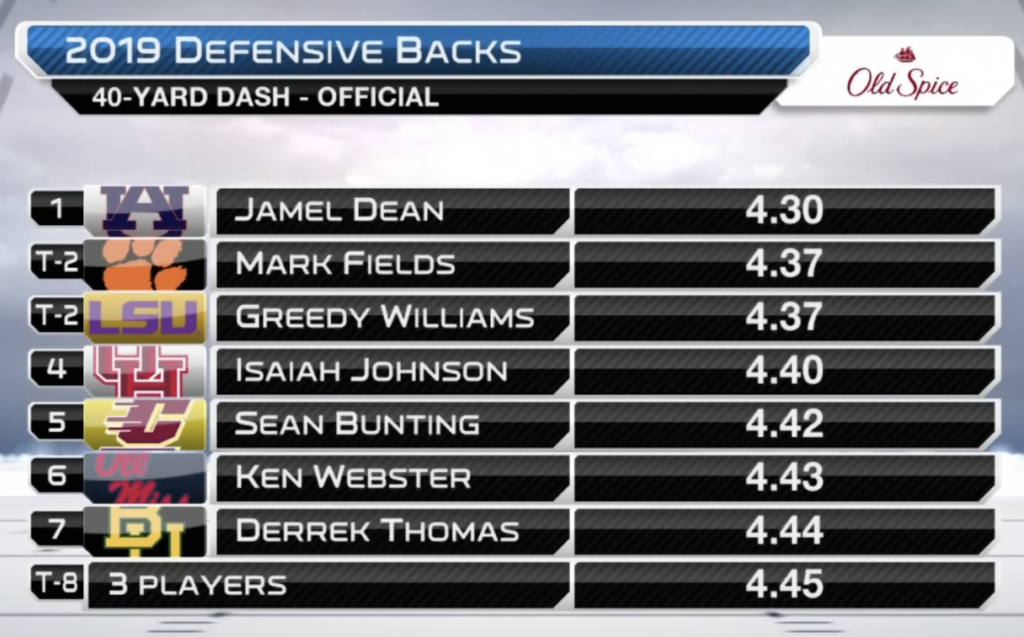

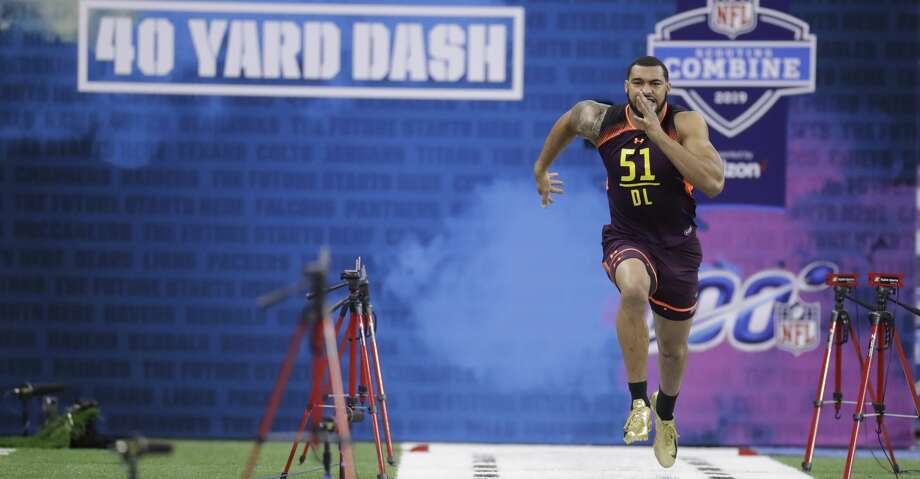
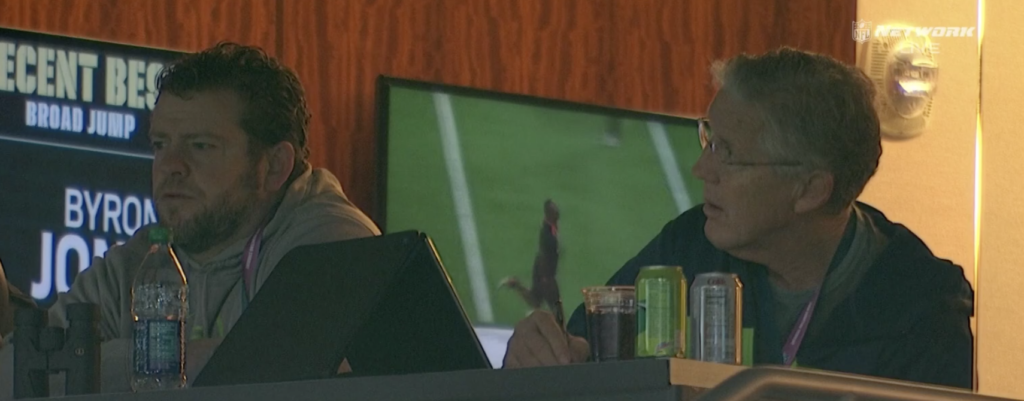
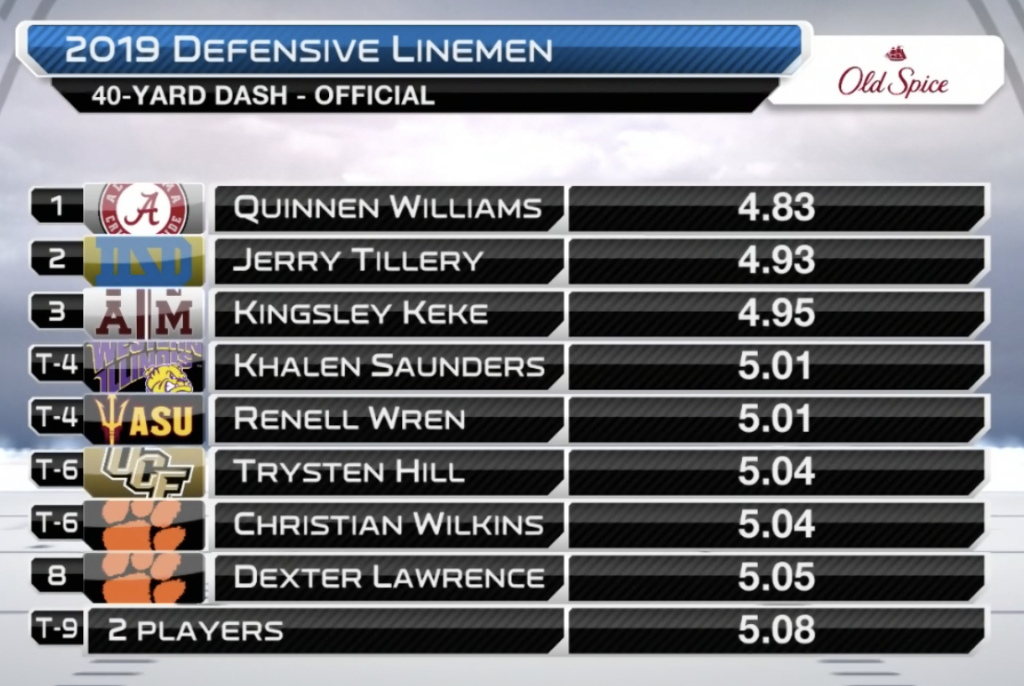

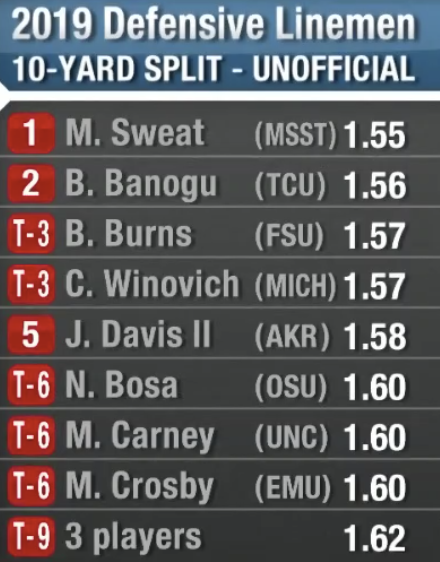
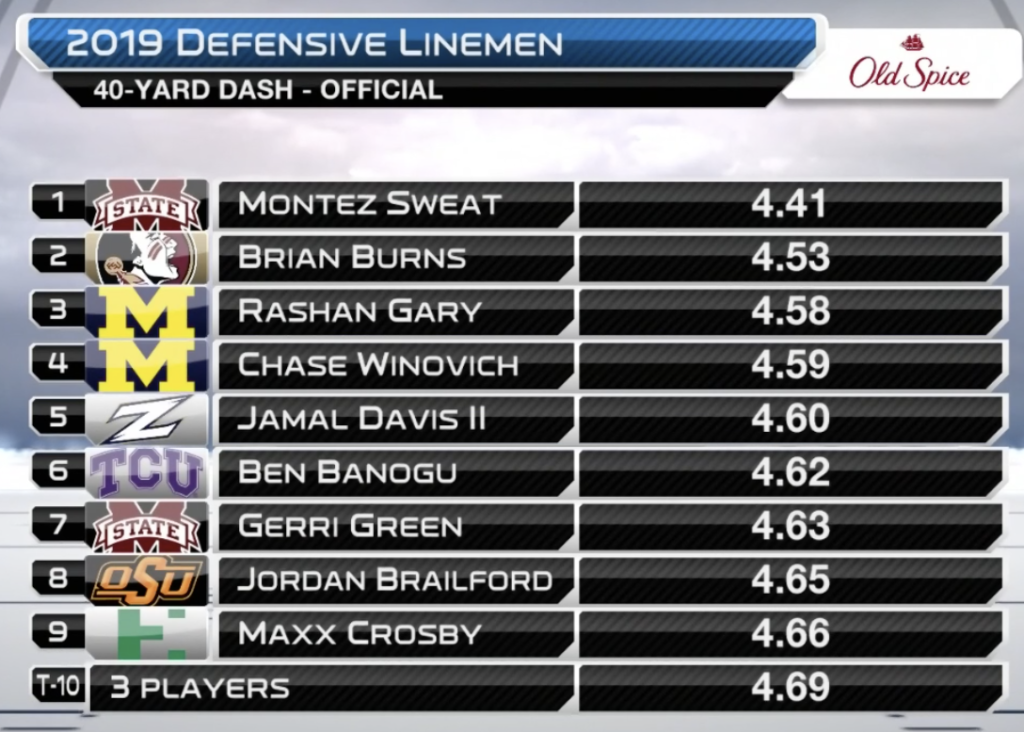
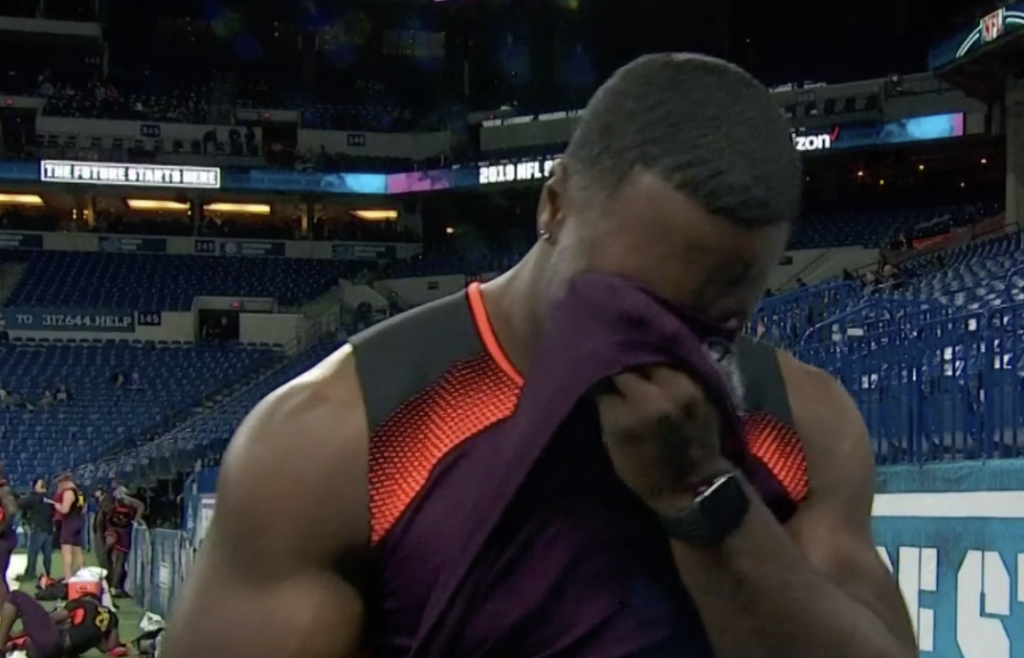
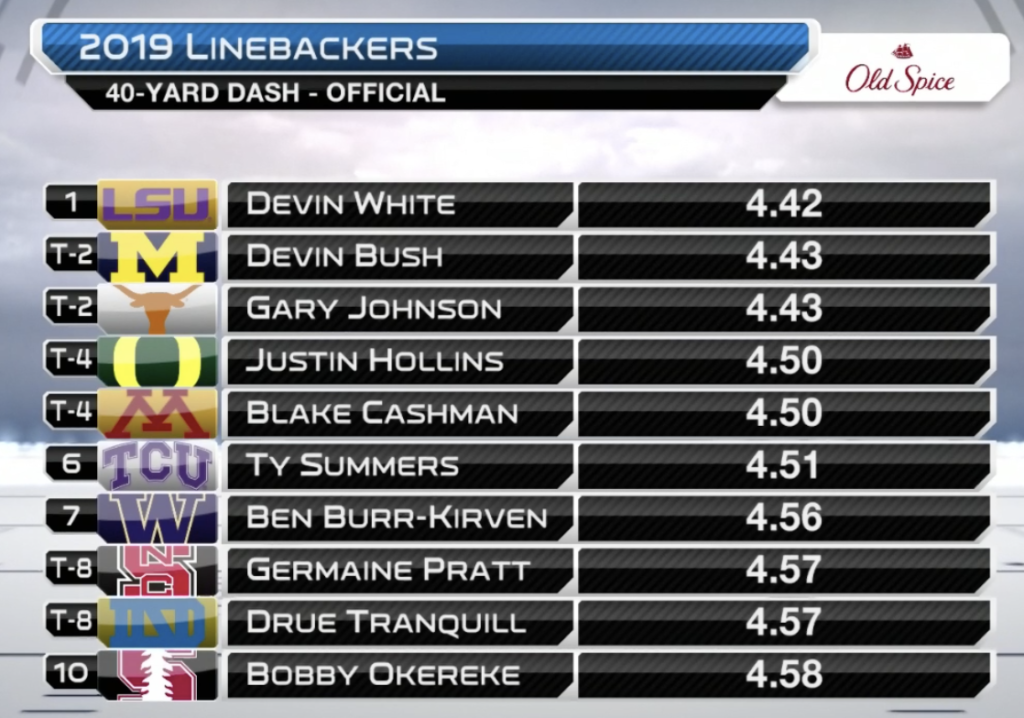

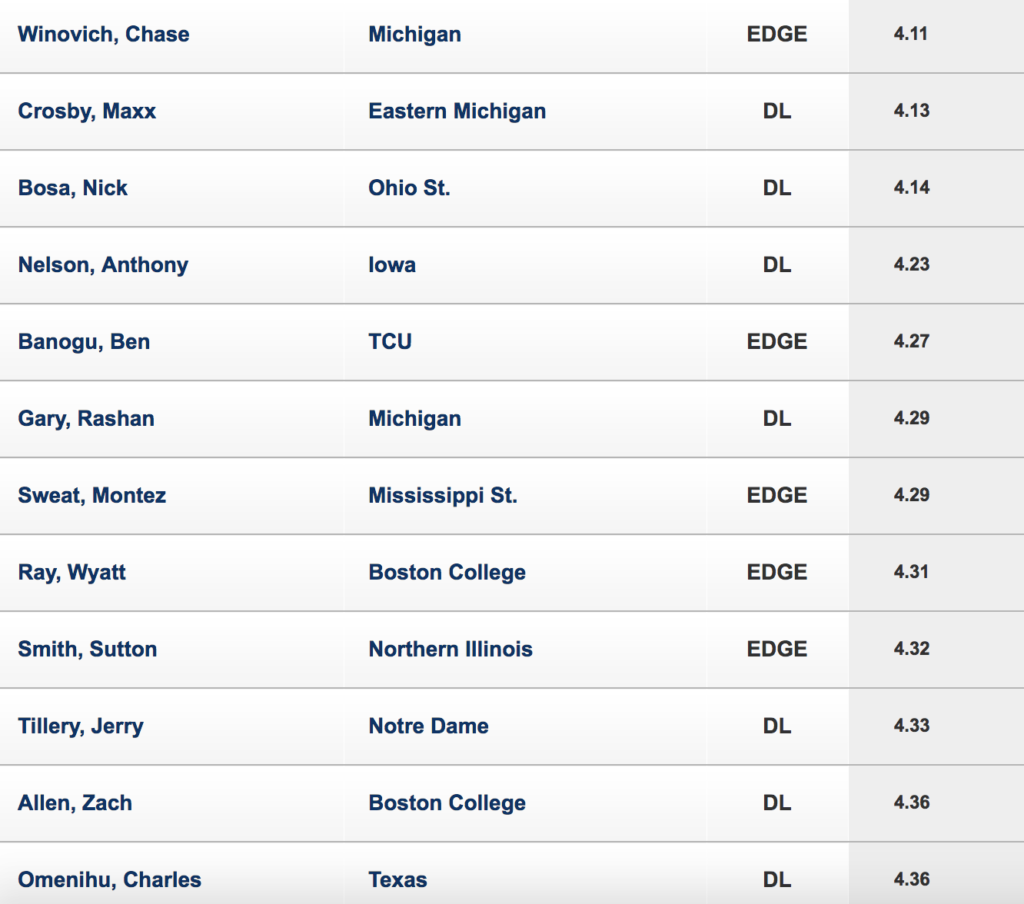


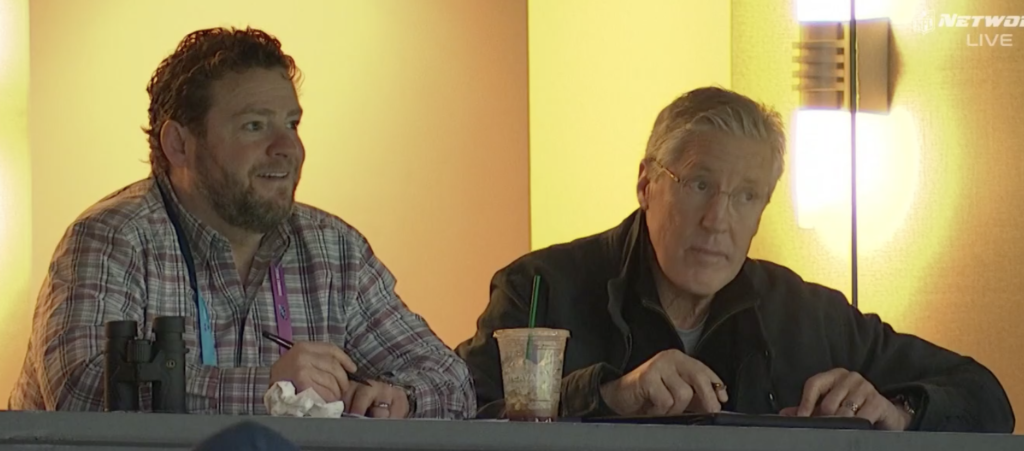
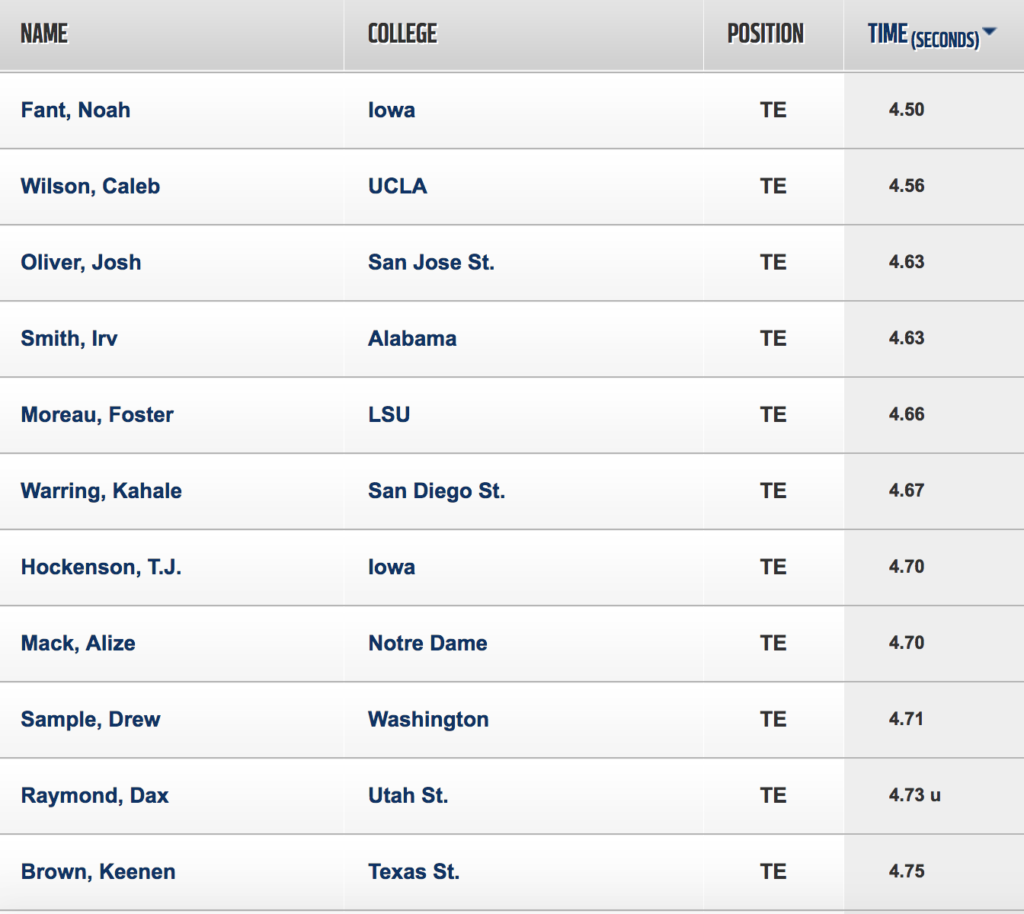


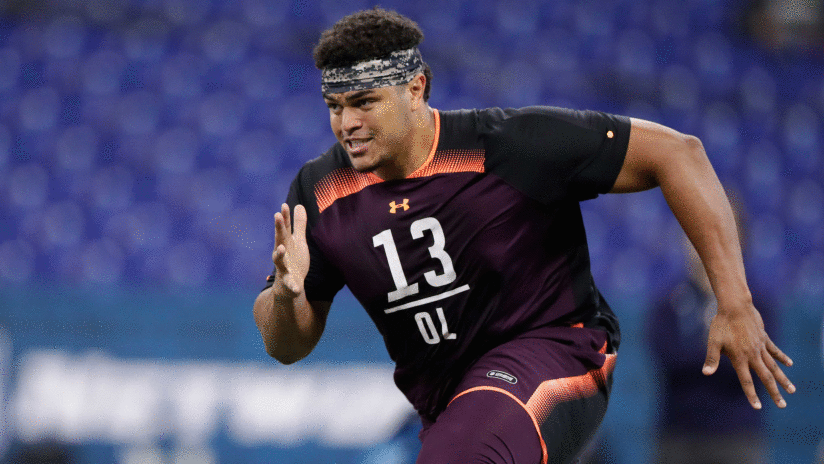

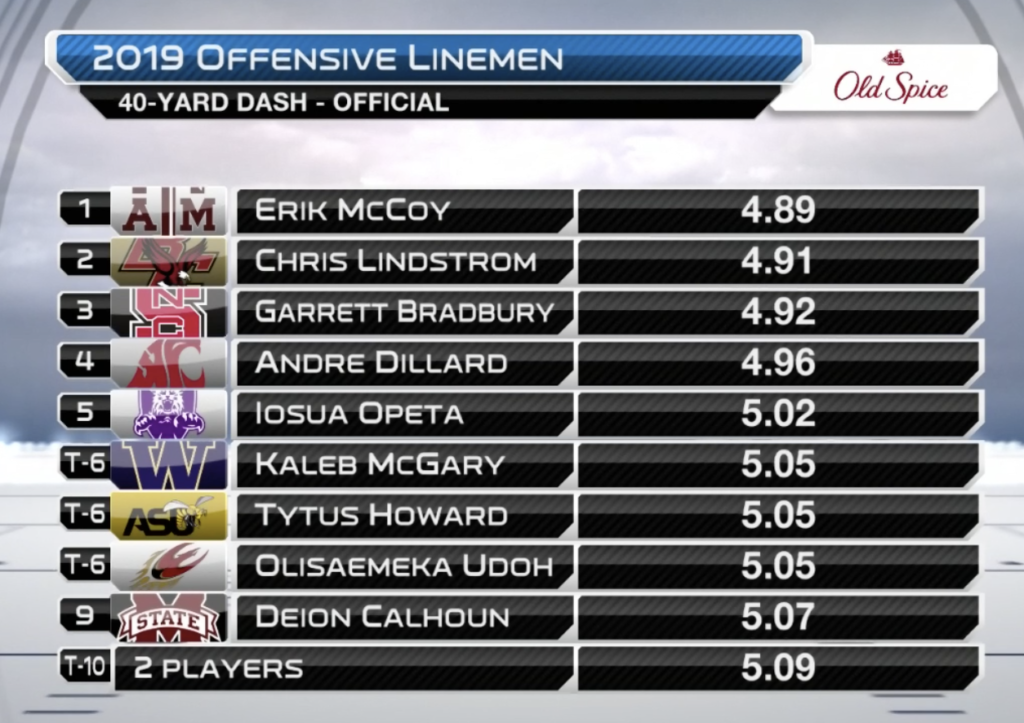
/cdn.vox-cdn.com/uploads/chorus_image/image/62995958/1033998718.jpg.0.jpg)
/cdn.vox-cdn.com/uploads/chorus_image/image/54018921/rodney_20anderson_20OU.0.jpg)
/cdn.vox-cdn.com/uploads/chorus_image/image/62649868/usa_today_11720673.1544325082.jpg)
/cdn.vox-cdn.com/uploads/chorus_image/image/62740526/1029486550.jpg.0.jpg)

/cdn.vox-cdn.com/uploads/chorus_image/image/62824988/usa_today_10350171.0.jpg)
/cdn.vox-cdn.com/uploads/chorus_image/image/59649359/usa_today_9800113.0.jpg)
/cdn.vox-cdn.com/uploads/chorus_image/image/58114137/5511890.0.jpg)

